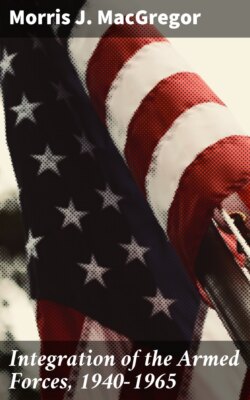Читать книгу Integration of the Armed Forces, 1940-1965 - Morris J. MacGregor - Страница 25
На сайте Литреса книга снята с продажи.
Progressive Experiments
ОглавлениеCommander Sargent
Since the inception of black enlistment there had been those in the Bureau of Naval Personnel who argued for the establishment of a group to coordinate plans and policies on the training and use of black sailors. Various proposals were considered, but only in the wake of the racial disturbances of 1943 did the bureau set up a Special Programs Unit in its Planning and Control Activity to oversee the whole black enlistment program. In the end the size of the unit governed the scope of its program. Originally the unit was to monitor all transactions involving Negroes in the bureau's operating divisions, thus relieving the Enlisted Division of the critical task of distributing billets for Negroes. It was also supposed to advise local commanders on race problems and interpret departmental policies for them. When finally established in August 1943, the unit consisted of only three officers, a size which considerably limited its activities. Still, the unit worked diligently to improve the lot of the black sailor, and eventually from this office would emerge the plans that brought about the integration of the Navy.
The Special Programs Unit's patron saint and the guiding spirit of the Navy's liberalizing race program was Lt. Comdr. Christopher S. Sargent. He never served in the unit himself, but helped find the two lieutenant commanders, Donald O. VanNess and Charles E. Dillon, who worked under Capt. Thomas F. Darden in the Plans and Operations Section of the Bureau of Naval Personnel and acted as liaison between the Special Programs Unit and its civilian superiors. A legendary figure in the bureau, the 31-year-old Sargent arrived as a lieutenant, junior grade, from Dean Acheson's law firm, but his rank and official position were no measure of his influence in the Navy Department. By birth and training he was used to moving in the highest circles of American society and government, and he had wide-ranging interests and duties in the Navy. Described by a superior as "a philosopher who could not tolerate segregation,"[3–58] Sargent waged something of a moral crusade to integrate the Navy. He was convinced that a social change impossible in peacetime was practical in war. Not only would integration build a more efficient Navy, it might also lead the way to changes in American society that would bridge the gap between the races.[3–59] In effect, Sargent sought to force the generally conservative Bureau of Naval Personnel into making rapid and sweeping changes in the Navy's racial policy.
During its first months of existence the Special Programs Unit tried to quiet racial unrest by a rigorous application of the separate but equal principle. It began attacking the concentration of Negroes in large segregated groups in the naval districts by creating more overseas billets. Toward the end of 1943, Negroes were being assigned in greater numbers to duty in the Pacific at shore establishments and aboard small defense, district, and yard craft. The Bureau of Naval Personnel also created new specialties for Negroes in the general service. One important addition was the creation of black shore patrol units for which a school was started at Great Lakes. The Special Programs Unit established a remedial training center for illiterate draftees at Camp Robert Smalls, drawing the faculty from black servicemen who had been educators in civilian life. The twelve-week course gave the students the equivalent of a fifth grade education in addition to regular recruit training. Approximately 15,000 Negroes took this training before the school was consolidated with a similar organization for whites at Bainbridge, Maryland, in the last months of the war.[3–60]
At the other end of the spectrum, the Special Programs Unit worked for the efficient use of black Class A school graduates by renewing the attack on improper assignments. The bureau had long held that the proper assignment of black specialists was of fundamental importance to morale and efficiency, and in July 1943 it had ordered that all men must be used in the ratings and for the types of work for which they had been trained.[3–61] But the unit discovered considerable deviation from this policy in some districts, especially in the south, where there was a tendency to regard Negroes as an extra labor source above the regular military complement. In December 1943 the Special Programs Unit got the bureau to rule in the name of manpower efficiency that, with the exception of special units in the supply departments at South Boston and Norfolk, no black sailor could be assigned to such civilian jobs as maintenance work and stevedoring in the continental United States.[3–62]
These reforms were welcome, but they ignored the basic dilemma: the only way to abolish concentrations of shore-based Negroes was to open up positions for them in the fleet. Though many black sailors were best suited for unskilled or semiskilled billets, a significant number had technical skills that could be properly used only if these men were assigned to the fleet. To relieve the racial tension and to end the waste of skilled manpower engendered by the misuse of these men, the Special Programs Unit pressed for a chance to test black seamanship. Admiral King agreed, and in early 1944 the Bureau of Naval Personnel assigned 196 black enlisted men and 44 white officers and petty officers to the USS Mason, a newly commissioned destroyer escort, with the understanding that all enlisted billets would be filled by Negroes as soon as those qualified to fill them had been trained. It also assigned 53 black rated seamen and 14 white officers and noncommissioned officers to a patrol craft, the PC 1264.[3–63] Both ships eventually replaced their white petty officers and some of their officers with Negroes. Among the latter was Ens. Samuel Gravely, who was to become the Navy's first black admiral.
